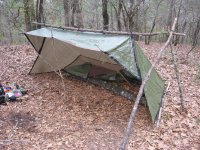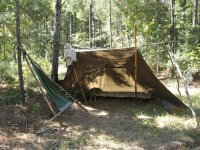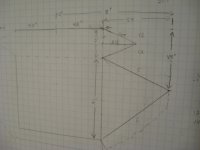Was prepping for my test trip last year, an realized that I did not have a tent of any description. I don't really want to borrow my parents' dome, and I don't want to put a ton of cash into something.
I've been looking at tarp-tents, etc for a bit, and realize "Hey! I have about 13' of 60" 6oz. Dacron left over from the SOF Build! It shouldn't take long to do something with that!"
(Many of my projects seem to start in a similar fashion. Go figure.)
I figure something along the lines of a Whelan Lean, since soooo many people seem to love it. But, I only have so much fabric, and no time to order more. So it gets scaled down. Some minor accessories later, and I've learned the following:
- Given Upholstery Thread and Denim Needles, a home sewing machine can handle multiple layers of Dacron just fine. Just go gentle.
- Cheap Tulle from the Mall-Wart may make a decent Mosquito Block, but it is a pain to sew. Especially when you're trying to interface it w/said Dacron.
- Said Tulle needs to have a border fabric on all edges to keep it under control. Preferably with zips/ties to hold it down, which sort of defeats the purpose of the Whelan's configurabillity options.
- I'm bad a project estimation. (This I should know, but I was actually putting in grommets out in the field. That's pushing it a bit.)
Field test taught the following:
- Need good stakes! See This Thread/Post.
- Dacron blocks wind very well! (It's sailcloth, so this should not be a surprise...)
- Without good stakes, it's hard to get the flaps to overlap in a way that blocks most mosquitoes. (Wind was high enough that this was not a huge deal, but still.
I think that this would have kept me dry in anything short of a monsoon, as long as the orientation was right, but... the space was limited.
I didn't get rained on, but if there was more than a light sprinkle (Enough that I wanted to stay in camp) the plan was to supplement with a Flat/Rectangular tarp for loafing about.
So, more experienced outdoors people: What do you look for when balancing cozy vs. room to do a little work in?
I've been looking at tarp-tents, etc for a bit, and realize "Hey! I have about 13' of 60" 6oz. Dacron left over from the SOF Build! It shouldn't take long to do something with that!"
(Many of my projects seem to start in a similar fashion. Go figure.)
I figure something along the lines of a Whelan Lean, since soooo many people seem to love it. But, I only have so much fabric, and no time to order more. So it gets scaled down. Some minor accessories later, and I've learned the following:
- Given Upholstery Thread and Denim Needles, a home sewing machine can handle multiple layers of Dacron just fine. Just go gentle.
- Cheap Tulle from the Mall-Wart may make a decent Mosquito Block, but it is a pain to sew. Especially when you're trying to interface it w/said Dacron.
- Said Tulle needs to have a border fabric on all edges to keep it under control. Preferably with zips/ties to hold it down, which sort of defeats the purpose of the Whelan's configurabillity options.
- I'm bad a project estimation. (This I should know, but I was actually putting in grommets out in the field. That's pushing it a bit.)
Field test taught the following:
- Need good stakes! See This Thread/Post.
- Dacron blocks wind very well! (It's sailcloth, so this should not be a surprise...)
- Without good stakes, it's hard to get the flaps to overlap in a way that blocks most mosquitoes. (Wind was high enough that this was not a huge deal, but still.
I think that this would have kept me dry in anything short of a monsoon, as long as the orientation was right, but... the space was limited.
I didn't get rained on, but if there was more than a light sprinkle (Enough that I wanted to stay in camp) the plan was to supplement with a Flat/Rectangular tarp for loafing about.
So, more experienced outdoors people: What do you look for when balancing cozy vs. room to do a little work in?






